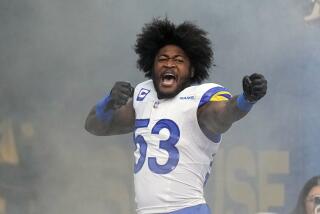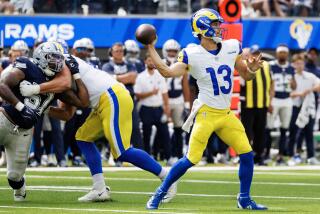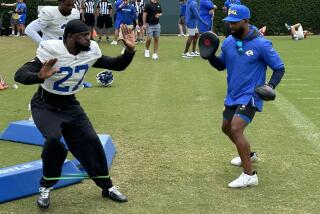RAMS : Minicamp Is of Major Importance for Several Veterans
The preambles, private messages and all those subtle little things that make up a coachâs unofficial introduction to his new football team are over now.
On Monday, when the weeklong mini-camp begins, the Ram players are finally going to get to know Chuck Knox up close and very personal, just the way he wants them to: working on the practice field.
The draft choices and rookie free agents join the party Thursday evening and, by NFL rules, can only work out with the team a few days. The serious stuff happens before the new blood arrives, in shorts and helmets, when the veterans try to wash away the sins of 1991.
What better way for Knox to start weeding out the deadwood--and he will do plenty of that--than to see which vets report in shape, which show the ability to adapt to new ideas, and which appear to be better players than they did on last yearâs films.
âOne, we want to see what kind of condition our veteran players are in,â Knox said this week of the mini-camp. âTwo, we want to introduce some new things that weâre going to be doing, offensively and defensively.
âAnd the third thing is we want to get a feel for the talent level, at least as athletes. Weâre not going to put on pads, that type of thing. (But) weâll get a feel for who can run or who can move and get a look at them.â
Hereâs a look at a few Ram veterans who, because of their play last year, their reputations or this weekâs draft collection, are looking at one of the more important weeks of their Ram careers:
Cleveland Gary--Knox wasnât hiding his desire to land a big-time running back in the draft, but he didnât select a back until the sixth round, when they got Middle Tennessee Stateâs Joe Campbell.
Somebody is going to have to emerge at tailback because Knox builds much of his offense around the set-in-stone assumption that every time he calls a running play, the offense will be four yards closer to the end zone.
Robert Delpino had a great year in â91, but as his breakout season progressed, it also further proved that heâs most dangerous as a situation player, not a 30-carry workhorse.
That gives the initial edge to Gary, but not unless he rebounds from his dismal 1991 season (only 68 carries, with 27 of those coming in the final two meaningless games). Gary will be 26 Monday, and thatâs middle aged for an NFL runner.
His up-and-down career has been sidetracked by the two weaknesses Knox will not tolerate: chronic fumble-itis and susceptibility to nagging injury.
If Gary can impress Knox immediately, show a dedication to holding onto the ball and to staying in the lineup, Gary could step into this wide-open spot and maybe fulfill the promise of his 15-touchdown year in 1990.
If not . . . well, you only get so many chances in this league before your shot at stardom is gone.
Marcus Dupree, left unprotected and virtually forgotten, could impress the new staff by showing up in shape and hungry to play.
Darryl Henley--Henley, who has done nothing to deserve this fate other than to be one or two inches shorter than the ideal size of an NFL cornerback, has watched the Rams draft players specifically to take his starting spot in back-to-back seasons.
Last year, it was 6-0 Todd Lyght in the first round. But Lyghtâs long holdout and subsequent injury problems kept Henley at right corner long enough to show that he can play in this league at 5-9 and without a mind-boggling vertical leap or 40-yard dash numbers. When Lyght finally got into the lineup, he took Jerry Grayâs left corner spot.
This year, the new regime went after Pittsburghâs 5-10 Steve Israel (though theyâre listed only one inch apart, itâs pretty obvious Israel is at least two inches taller than Henley) with the 30th pick overall, and they didnât do it to replace Lyght.
Knox feels Israel better matches up with the taller, faster receivers prevalent in the NFC West. What Henley can do next week is show Knox why the size-speed numbers on paper arenât the entire story.
From the outset, if Henley is going to keep his job, he has to show heâs not going to be knocked out of the lineup without a fight, that he really was the Ramsâ best defensive back last season. He must show that if Israel needs a year of NFL fine-tuning before heâs ready to stare down the Andre Risons of the league, the Rams wonât be sitting ducks if Henley is playing 60 downs a game.
Aaron Cox--At least Knox has brought in only one person to go after Henleyâs job. Heâs got two for Coxâs, whose hamstrung Ram career has never come close to justifying his first-round selection in 1988.
Knox signed former Seattle Seahawk Jeff Chadwick in Plan B, drafted LSU receiver Todd Kinchen in the third round, and with both acquisitions talked about their toughness, their blocking abilities and their willingness to catch key over-the-middle passes.
None of which are Coxâs major talents.
Playing behind starters Flipper Anderson and Henry Ellard, Cox has never caught more than 28 passes a season, and that was four years ago. Last year, he caught only 15 and even though he has home-run speed, he did not get to the end zone once.
Only a super mini-camp would vault Cox back into serious playing-time consideration heading into July. And if he should pull or aggravate one his hamstrings during a drill . . .
Pat Terrell--Last year, the aggressive Ram defensive coaches wanted Terrell to develop into their free-safety security blanket for blown man-to-man coverages, and he wasnât bad at it. But he only got one interception, and the role probably kept Terrell from doing what he does best: Fly up to the line of scrimmage and hit people.
Knox had Ken Easley making high-velocity tackles all over the field from a safety spot when he was in Seattle. The new defensive staff is hoping Terrell can supply that kind of intimidation in addition to helping in the deep zones.
This mini-camp will begin to show how prepared Terrell is to make the transition from last yearâs man-to-man, help-everywhere style to this yearâs possibility of letting the free safety play as a power-hitting rover back.
Some Last Draft Notes: It was crazy enough on the Saturday night before Sunday morningâs kickoff to the NFL draft that the Rams were beginning to roll around in their minds how much it would take to sign Washington defensive tackle Steve Emtman once he slipped to them. They knew either Sean Gilbert (their eventual pick) or Emtman would be Indianapolisâ top pick, and knew that Quentin Coryatt was going to be the Coltsâ second choice. . . . The Ramsâ five-year, $7.2-million deal with Gilbert, agreed to hours after they selected him, was so easily accomplished because Gilbert had already established a value when he talked contract with the Colts and because it seemed relatively cheap to the Rams because of the $9-million price tag they knew Emtman would demand.
How influential was outgoing player personnel director John Math in this yearâs draft? A week before the draft, while complimenting Indiana tailback Vaughn Dunbar, he said Dunbarâs accomplishments were even more impressive given that âthe offensive linemen at Indiana left a lot to be desired.â That must have been news to Indiana left tackle Shawn Harper, who happened to be the Ramsâ fourth-round pick (No. 87 overall) and is one of the favorites to be the teamâs top back-up tackle in 1992.


